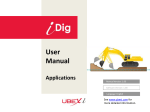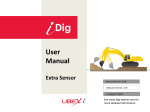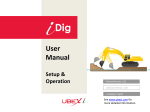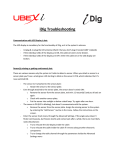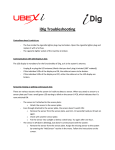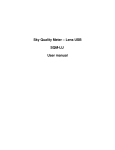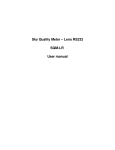Download User Manual
Transcript
User Manual Applications Manual Version: 2.00 Software Version: 2.03 Language: English See www.idig-system.com for more detailed information. Safety Information: Magnets Use caution with the powerful magnets in iDig mounting plates The mounting plates used to secure the sensors to the excavator use extremely strong rare earth magnets. They must be handled with care to avoid personal injury and damage to the magnets. Fingers and other body parts can get severely pinched between two attracting magnets or other metal surface. Use caution when removing the magnetic mounting plates from the carrying case. When handling them, be aware of their strong attraction to any nearby steel surface (such as the other mounting plates or metal back plates of the sensors). Other warnings about rare earth magnets Never allow rare earth magnets near a person with a pacemaker or similar medical aid. The strong magnetic fields of the magnet can affect the operation of such devices. The strong magnetic fields of rare earth magnets can also damage magnetic media such as credit cards, magnetic I.D. cards, cassette tapes, floppy disks, video tapes or other such items. They can also damage computer hard drives, televisions, VCRs, computer monitors and other CRT displays. Never place rare earth magnets near electronic appliances. Children should not be allowed to handle rare earth magnets as they can be dangerous. Small magnets pose a choking hazard and should never be swallowed or inserted into any part of the body. Rare earth magnets are brittle, and can peel, crack or shatter if allowed to slam together. Do not modify or machine them. Eye protection should be worn when handling these magnets, because shattering magnets can launch pieces at great speeds. They will lose their magnetic properties if heated above 80°C (175°F). Rare earth magnets should never be burned, as burning them will create toxic fumes. Safety Information: Laser SAFETY LABELS The One-Dot Laser used for first-time setup is a Class 2 laser, manufactured to comply with the international rules of safety IEC 60825-1, 2001. Although the power of the emission of the beam is less than 5mW in Class 2, the following cautions are recommended: • Do not stare directly at the beam • Do not set up the laser at eye level Introduction Use the system to dig with an excavator to a desired depth and create a leveled plane or to set a slope and create a tilted surface. Also use it to determine reach, such as for the width of a trench. All the digging information is referenced to the center of the bucket blade (or teeth) and the depth value shown is the distance from the actual teeth position to the target depth. Sensors measure the angle of the boom, stick, and bucket. The information is transmitted instantly to the cab display. LEDs tell you how far to dig. A simple one-time procedure allows the iDig system to “learn” the dimensions of your machine. That is how it constantly calculates, in real time, where the bucket tip is in relation to the target depth. Excavator rotation and movement With iDig, the operator has to dig “straight ahead” (only moving the booms/bucket in and out). After the target depth has been set, the chassis has to stay stable. Any rotation of it may produce an error depending on the inclination. Rotation of the chassis can be compensated by using a fourth sensor as a “pitch” sensor on the chassis. This will automatically correct forward and backward tilting movements of your machine as well as rotation, providing accurate depth information. Every time that the excavator tracks are moved, it’s necessary to zero again the reference (target) depth on a previous point or, depending on the setup, take the laser height again. Safety Information: Radio PRECAUTIONS The product must not be disposed with household waste. Dispose of the product appropriately in accordance with the national regulations in force in your country. FCC Labels on sensors & LED Display ELECTROMAGNETIC COMPATIBILITY (EMC) Description The term Electromagnetic Compatibility is taken to mean the capability of the product to function smoothly in an environment where electromagnetic radiation and electrostatic discharges are present, and without causing electromagnetic disturbances to other equipment. WARNING Electromagnetic radiation can cause disturbances in other equipment. Although the product meets the strict regulations and standards which are in force in this respect, the manufacturer cannot completely exclude the possibility that other equipment may be disturbed. CAUTION There is a risk that disturbances may be caused in other equipment if the product is used in conjunction with accessories from other manufacturers, for example field computers, personal computers, two-way radios, nonstandard cables or external batteries. Precautions: Use only the equipment and accessories recommended by the manufacturer. When combined with the product, they meet the strict requirements stipulated by the guidelines and standards. When using computers and two-way radios, pay attention to the information about electromagnetic compatibility provided by the manufacturer. CAUTION Disturbances caused by electromagnetic radiation can result in erroneous measurements. Although the product meets the strict regulations and standards within this respect, the manufacturer cannot completely exclude the possibility product may be disturbed by very intense electromagnetic radiation, near radio transmitters, two-way radios or diesel generators. Precautions: Check the plausibility of results obtained under these conditions. WARNING If the product is operated with connecting cables attached at one of their two ends, for example, external supply cables, interface cables, the permitted level of electromagnetic radiation may be exceeded and the correct functioning of other products may be impaired. Precautions: While the product is in use, connecting cables, for example product to external battery, product to computer, must be connected at both ends. Safety Information: Radio FCC STATEMENT, APPLICABLE IN U.S. WARNING This equipment has been tested and found to comply with the limits for a Class B digital device, pursuant to part 15 of the FCC rules. These limits are designed to provide reasonable protection against harmful interference in a residential installation. This equipment generates, uses and can radiate frequency energy and, if not installed and used in accordance with the instructions, may cause harmful interference to radio communication. However, there is no guarantee that interference will not occur in a particular installation. If this equipment does cause harmful interference to radio or television reception, which can be determined by turning the equipment off and on, the user is encouraged to try to correct the interference by one or more of the following measures: • Reorient or relocate the receiving antenna. • Increase the separation between the equipment and the receiver. • Connect the equipment into an outlet on a circuit different from that to which the receiver is connected. • Consult the dealer or an experienced radio/TV technician for help. Notice for Canada This Class B digital device meets all requirements of Canadian Radio Standards Specification RSS-210. Cet appareil numérique de la Class B respecte toutes les exigences du Règlement sur le matériel brouilleur du Canada. WARNING Changes or modifications not expressly approved by the manufacturer for compliance could void the user's authority to operate the equipment. RESPONSIBILITIES Manufacturer of the product: The manufacturer is responsible for supplying the product, including the user manual and original accessories, in a completely safe condition. Person in charge of the product: The person in charge of the product has the following duties: • To understand the safety instructions on the product and the instructions in the user manual. • To be familiar with local regulations relating to safety and accident prevention. • To inform the manufacturer immediately if the product and the application becomes unsafe. WARNING The person responsible for the product must ensure that it is used in accordance with the instructions. This person is also accountable for the training and the deployment of personnel who use the product and for the safety of the equipment in use. HAZARDS OF USE WARNING The absence of instruction, or the inadequate imparting of instruction, can lead to incorrect or adverse use, and can give rise to accidents with far-reaching human, material, financial and environmental consequences. Precautions: All users must follow the safety directions given by the manufacturer and the directions of the person responsible for the product. Keypad Press once: Press once: To confirm any setting in progress. For laser acquisition (reference the depth value to the laser plane). Press & hold: Press & hold: To enter the USER MENU. To set a depth value relating to the laser plane height. In the working screen: Press once: To scroll through the various operator screens. To set back the depth, slope or menu values to „0“. To delete the 1st laser In text menu: catch. To move the cursor down. Press & hold: In the working screen: To scroll through the various operator screens. In text menu: To move the cursor up. To set back the reach to „0“. To exit any menu point. Press once to cycle through the horn settings: Off, On, Loud. When horn is ON, alarm will sound to warn of overdigging if bucket is too low (accelerating beeps). Depth value setting: To set a new distance to the target depth. Calibration mode: To make the digits jump for faster settings. Press once: To change to an already calibrated bucket Press & hold: To calibrate a brand new bucket Short-press: To set a slope: % or ratio (eg: 1:2) Press & hold: To change from % to ratio. Press & hold to choose the dead band settings. Fine: 1cm (0.5“), Medium: 5cm (1“), Coarse: 10cm (2“) Digging a hole Method 1: Using the ground as reference Digging a hole Method 1: Using the ground as reference Set the reference: 1. Place the tip of the bucket on your final elevation (ground) 2. Short-press “0” The LCD screen and the LED display will indicate the difference of your bucket tip to the reference Note: If the working screen elevation can’t be zeroed out: - 1st Laser catch still active (laser star visible in 1st working screen): - Disable the 1st laser catch: Short-press “Laser”, short-press “0” - Previous preset elevation setting still active: - Short-press elevation, short-press “0”, “Enter” Digging a 2,50m deep hole Method 2: Using surveyor stake as reference Surveyor Stake 2,50m Digging a 2,50m deep hole Method 2: Using surveyor stake as reference Set the reference: 1. Place the tip of the bucket on the surveyor stake 2. Short-press “0” Set the depth: 1. Short-press „Elevation“ 2. Dial-in -2.50 using „Down“ 3. Confirm with „Enter“ Note: The sign of the dialed-in value will change after confirmation with “Enter”, as the bucket tip will be (in this case) 2.50 higher(+) than the reference The LCD screen and the LED display will indicate the difference of your bucket tip to the reference Digging a 2,50m deep by 5m wide hole Surveyor Stake 5m 2,50m Digging a 2,50m deep by 5m wide hole Set the reference: 1. Place the tip of the bucket on the surveyor stake 2. Short-press “0” Set the depth: 1. Short-press „Elevation“ 2. Dial-in -2.50 using „Down“ 3. Confirm with „Enter“ Zero the reach: 1. In the 2nd operating screen long-press „0“ 2. When the reach indication shows „5.00“, you are at the 5m width for your hole, and may re-zero the reach again 5 Digging a hole using a rotating laser Method 1: Knowing the laser height Laser Receiver Laser Height (2,21m + 2,50m) 2,21m 4,71m Surveyor Stake 2,50m Digging a 2,50m deep hole using a rotating laser Method 1: Knowing the laser height Catch the laser: 1. Long-press „Laser“ 2. Dial-in 4,71 using „Up“ 3. Confirm with „Enter“ 4. Catch the laser beam 5. Confirm catch with „Enter“ Every time you‘ve moved the machine: 1. Short-press „Laser“ 2. Catch the laser beam 3. Confirm catch with „Enter“ Digging a 2,50m deep hole using a rotating laser Method 2: Not knowing the laser height Laser Receiver Surveyor Stake 2,50m Digging a 2,50m deep hole using a rotating laser Method 2: Not knowing the laser height Set the reference: 1. Place the tip of the bucket on the surveyor stake 2. Short-press “0” Set the depth: 1. Short-press „Elevation“ 2. Dial-in -2.50 using „Down“ 3. Confirm with „Enter“ Catch the laser: 1. Short-press „Laser“ 2. Catch the laser beam 3. Confirm catch with „Enter“ Every time you‘ve moved the machine: 1. Short-press „Laser“ 2. Catch the laser beam 3. Confirm catch with „Enter“ Digging a trench with 2% slope Method 1: Using the ground as reference Digging a trench with 2% slope Method 1: Using the ground as reference Set the reference & slope: 1. Short-press “%” 2. Dial-in 2.00% using „Up“ 3. Confirm with „Enter“ 4. Place the tip of the bucket on your final elevation 5. Short-press “0” Note: -Slope is positive when lower in front of the cab -Direction of slope is also indicated by the triangle symbol Same as when digging a horizontal reference, the LCD screen and the LED display will indicate the difference of your bucket tip to the reference Note: You have to dig straight, not leaving the slope’s axis by rotating the cab. A slew of the cab out of the axis will instantly lead to a loss of accuracy! Digging a 2,50m deep trench with 2% slope Method 2: Using surveyor stake as reference Surveyor Stake 2,50m Digging a 2,50m deep trench with 2% slope Method 2: Using surveyor stake as reference Set the slope: 1. Short-press “%” 2. Dial-in 2.00% using „Up“ 3. Confirm with „Enter“ Set the reference: 1. Place the tip of the bucket on the surveyor stake 2. Short-press “0” Set the depth: 1. Short-press „Elevation“ 2. Dial-in -2.50 using „Down“ 3. Confirm with „Enter“ Same as when digging a horizontal reference, the LCD screen and the LED display will indicate the difference of your bucket tip to the reference Digging a trench with 2% slope using a rotating slope laser Method 1: Knowing the laser height Note: If you‘re using a rotating laser to dig a trench with slope, it‘s mandatory that it‘s a slope laser and to set the same slope on the laser as in the trench! Laser Receiver Laser Height (2,42m + 2,50m) 2,42m 4,92m Surveyor Stake 2,50m Digging a trench with 2% slope using a rotating slope laser Method 1: Knowing the laser height Set the slope: 1. Short-press “%” 2. Dial-in 2.00% using „Up“ 3. Confirm with „Enter“ Catch the laser: 1. Long-press „Laser“ 2. Dial-in 4.92 using „Up“ 3. Confirm with „Enter“ 4. Catch the laser beam 5. Confirm catch with „Enter“ Every time you‘ve moved the machine: 1. Short-press „Laser“ 2. Catch the laser beam 3. Confirm catch with „Enter“ Digging a 2,50 deep trench with 2% slope using a rotating slope laser Method 2: Not knowing the laser height Laser Receiver Note: If you‘re using a rotating laser to dig a trench with slope, it‘s mandatory that it‘s a slope laser and to set the same slope on the laser as in the trench! 2,50m Surveyor Stake Digging a 2,50 deep trench with 2% slope using a rotating slope laser Method 2: Not knowing the laser height Set the slope: 1. Short-press “%” 2. Dial-in 2.00% using „Up“ 3. Confirm with „Enter“ Set the reference: 1. Place the tip of the bucket on the surveyor stake 2. Short-press “0” Set the depth: 1. Short-press „Elevation“ 2. Dial-in -2.50 using „Down“ 3. Confirm with „Enter“ Catch the laser: 1. Short-press „Laser“ 2. Catch the laser beam 3. Confirm catch with „Enter“ Every time you‘ve moved the machine: 1. Short-press „Laser“ 2. Catch the laser beam 3. Confirm catch with „Enter“ Digging a 1:1 sloped embankment Digging a 1:1 sloped embankment Set to “x:y” slope mode 1. Long-press „%“ 2. Select „x:y“ using „down“ 3. Confirm with „Enter“ Set the reference & slope: 1. Short-press “%” 2. Press „Enter“ to set X value 3. Dial-in „1“ using „Up“ 4. Confirm with „Enter“ 5. Press „Down“ & „Enter“ to set Y value 6. Dial-in „1“ using „Up“ 7. Confirm with „Enter“ 8. Press „Down“ & „Enter“ to exit setting 9. Place the tip of the bucket on your final elevation 10. Short-press “0” Note: -Slope is positive when lower in front of the cab -Direction of slope is also indicated by the triangle symbol Changing the elevation Method 1: Working without a rotating laser Surveyor Stake 2,50m 2,40m 0,10m Changing the elevation Method 1: Working without a rotating laser Change the reference: 1. Short-press „Elevation“ 2. Dial-in „-2.40“ using „Up“ 3. Confirm with „Enter“ Changing the elevation Method 1: Working with a rotating laser 4,71m 4,61m 0,10m Changing the elevation Method 1: Working with a rotating laser Change the reference: 1. Long-press „Laser“ 2. Dial-in 4.61 using „Down“ 3. Confirm with „Enter“ 4. Catch the laser beam 5. Confirm catch with „Enter“ Note: INCREASE the Laser Height to dig DEEPER DECREASE the Laser Height to dig HIGHER Working with the iDig Laser Receiver Note: Be sure that the iDig Laser Receiver is assigned to the system and calibrated to the machine. Refer to the „User Manual iDig (Setup & Operation)“ for details. To catch the laser beam, press „Laser“ Laser beam not touching the laser receiver‘s reception field (horizontal LED bar red) Note: In case the iDig laser receiver hasn’t been assigned to the system yet, or you’re using another machine control laser receiver together with the system, both horizontal & vertical LED bar will be green Laser beam touching the laser receiver‘s reception field, but receiver is too high (horizontal LED bar green, and vertical LED bar yellow) Working with the iDig Laser Receiver Laser beam touching the laser receiver‘s reception field, but receiver is too low (horizontal LED bar green, and vertical LED bar red) Laser beam on-grade (both horizontal & vertical LED bar green) Confirm catch with „Enter“ The laser star at the bottom right indicates the successful laser catch Short-press „Laser“ & „0“ to delete the 1st catch

































